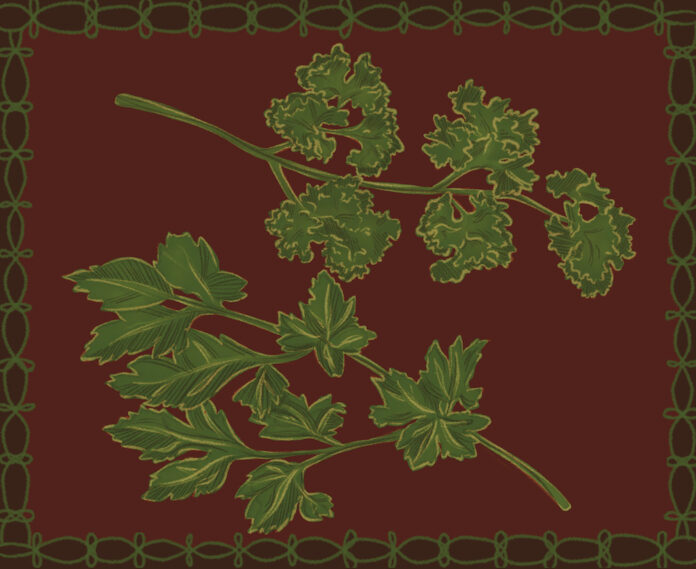I was, as I often am, curled up on my couch before bed catching up on my YouTube subscriptions. Inspired by a craving for a midnight snack, I clicked a video on how to make poutine. It was an enjoyable video, an easy-to-follow recipe with variations for easy and fancy versions. At least, until I got to the garnishing segment.
“And finally, garnish beautifully with some flat-leaf Italian parsley. Because curly leaf is pure evil,” Joshua Weissman, the food YouTuber cooking on my screen shouted out into the internet void.
I sat up. I was annoyed, questioning why this line was included. There was no follow-up, no explanation. “Do this, because I said so,” it seemed to say.
But curly parsley isn’t evil. Just like any ingredient, there is nothing inherently “bad” about it. Rather, cooking enthusiasts have created a limiting perspective about when and where curly parsley is acceptable. By creating a sense of elitism around the ingredient, cooks are able to craft dishes that come across as more “hip” merely because of the exclusion or inclusion of an ingredient. Curly parsley is just one of the most prevalent victims.
Curly parsley garnishes have been prominent in home cooking since the mid-20th century as garnishing indicated the time that could be spent on meals. Especially as Julia Child and James Beard’s French-style cooking dominated the mainstream American food scene, the motivation to impress through food grew stronger. Curly parsley adorned edges of dishes en masse in an attempt to elevate their appearance and capture the sense of luxury and liveliness of French cooking, even on meals one would only dare to call French.
Eventually, curly parsley fell out of favor with home and TV chefs preferring and praising the flat-leaf Italian variety. But curly parsley didn’t go away; instead, it became widely shunned. Using flat-leaf parsley created a sense of sophistication, and this narrative ran curly parsley into the ground. This 1997 recipe in the New York Times even suggests using flat-leaf parsley for tabbouleh, a dish where many agree curly parsley is the better choice — if not the only one.
The internet’s role in the creation of an elitist food mindset shouldn’t be ignored. It’s largely accepted that anger is what gets interaction, those angry “yessssss” Instagram DMs and Facebook replies under just about anything. Not only does the existence of many communities on the internet practically rely on having something to mutually hate, but food spaces are especially plagued by the necessity for novelty. Articles come out daily trying to claim to be onto the “next big thing” in the food space whether that be an ingredient, a technique or a dish. Each iteration must be better, more innovative and more interesting than the last.
So with this hate-first narrative combining with cooks’ need to outperform themselves and others, a persona’s public investment in a stance against a certain ingredient creates room for negative conversation which drives clicks, comments, and views. As readers and consumers of food content, we are told what to like, what to buy, what to use, what is in and what is out. We create parasocial relationships with the people whose content we consume and trust them above ourselves. We fail to consider that maybe they could be wrong.
I’m not trying to tell you that curly parsley is good. I’m telling you to do your own research.
And truthfully, I agree with the people — I don’t think curly parsley’s place in a dish is as a garnish. Flat-leaf is more visually appealing when very roughly chopped and sprinkled over a dish. But curly parsley’s less intense flavor won’t dominate an herb salad, and its structural integrity allows it to add height, and therefore lightness, to a dish. To write off an entire ingredient because of what people you don’t know have told you is to write off an entire range of possibilities.
As the internet and strangers’ opinions slowly dominate our conversations around food, I find it helpful to ground myself in the food I know. When I’m home with my parents, I find myself at the kitchen counter, across from my mom, watching her cook. I ask about ingredients, techniques and experiences. When you talk about food face-to-face, you’re not talking to increase engagement statistics with an invisible audience; you’re talking to learn, connect and grow. When I watch people cook, it’s like watching a part of their personality. The recipes they use, the things they swear by, their “secret techniques,” all tell you about how they see themselves reflected in their food. We have always learned by watching and following those who came before us. If we allow ourselves to forget what we “must” do and instead try and find what we actually enjoy eating and cooking, we can center ourselves and our enjoyment in our food. Cooking is an art, not a science, and there are no right answers.
Next time you’re at the grocery store, pick up something you’ve been told isn’t good: a bunch of curly parsley, a tin of sardines or maybe a can of SPAM. Whether you find yourself hating it or loving it, you’ve deepened your relationship with your food and made a decision about what’s good that’s entirely your own. Eventually, you will find something you love, and you’ll thank yourself for trying something new.
![]()



































